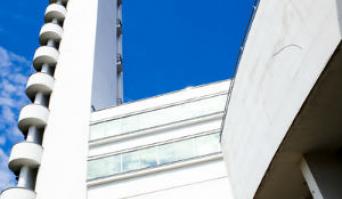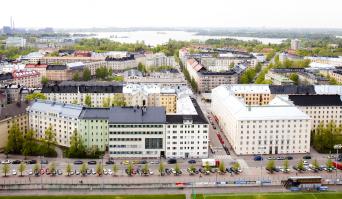The Tower is very characteristic and identifies the Helsinki Olympic Stadium among its peers around the world. It is also one of the best known constructions and sites in Helsinki and Finland. The 80 years of the Tower’s history are made of many stories and celebrations. At 72 metres from the ground, the Tower of the Olympic Stadium is one of the best place to admire Helsinki from high above. The Tower is open on weekdays until 21.00 and on weekends until 17.00. The opportunity to see the underlying city in evening lights has been a great attraction throughout the years.
Open views to the city
The Tower of the Stadium is an icon in its own right. It has been a venue for falling in love – according to the wartime legend, the spark flared in the Tower between a “Lotta”, member of the Finnish women's auxiliary services and an air defence serviceman – for popping the question and even for celebrating the wedding. No wonder, since the Tower offers the best view to admire Helsinki. Especially the light-spotted cityscape over the Helsinki in the dusk is very impressive. The Tower offers the excitement of the all-around views over Helsinki.
OPENING HOURS
MON-FRI 8-21
SAT 10-17
SUN 12-17
Check the exceptions HERE.
You can buy tickets from Visitor Centre or in advance from Lippupiste.
Adults 7,5 €
Children 7-16 years 4,5 € (under 7 year-olds free of charge)
Discount groups 4,5 € (students, pensioners, persons in military service or civilian service, unemployed)
Groups more than 10 persons: Adults 5,5 €. Kids / youths and discountgroups 3,5€. Tour leader free of charge (Tickets from Visitor Center)
Tower and TAHTO Sports Museum 20€. Kids / youths 9€. Discountgroups 14€. Tickets from Visitor Center or from Tahto.
Lippupiste will only charge eventual booking or payment fees for ticket delivery. The order fee will be added to the price based on the type of delivery chosen.
Important information for visitors
- To reach the top of the Tower visitors need to take an elevator and a few stairs. The viewpoint is an outside area so the viewpoint might be slippery.
Please note that due to the structures built in the 1930s, there unfortunately is not an accessible route to the top of the tower. Read more about the accessibility of the Helsinki Olympic Stadium. - The entrance for the visit to the Tower and the guided tours is the Visitor Centre of the Stadium (Tower entrance).
- Lippupiste charges order and payment method fees for tickets purchased through Lippupiste. The order fee is added to the total price of the order based on the chosen delivery method (the order fee for tickets is €1.50 + 0.65% of the total order).
Should it become necessary to cancel any events or visits to the Stadium, the Stadium Foundation will not be responsible for any expenses potentially incurred by the participants. If the events or visits must be postponed, the tickets will be valid for a new time slot. Please follow the Olympic Stadium information channels for eventual changes
History of the Tower
The Stadium designers, the architects Toivo Jäntti and Yrjö Lindegren placed the Tower as the guard of the stadium’s main entrance. In the past, the Tower was called with the name “the Marathon Tower”. In those days, the Tower was associated with the symbolic notion that when the marathon runners saw the first glimpse of the Tower, it would signify for them the beginning of the last leg, an inspiration for the final spurt. The Olympic fire was to be lit in the Stadium Tower already in 1930. The organising committee of the Games decided to give up the hosting of the XII Olympiad because the world situation did not favour the arrangement of the Games. In the spring of 1941, the Tower was closed for the public and, during the WW2 years, it was used as the observation station of the Helsinki air raid protection centre. Indeed, the Stadium Tower played an important role for the Finnish air defence during the war in 1941-1944. The Tower was not reopened until 3 March 1945 after the end of WW2. During the 40s, the Tower assumed a new, symbolic significance as it was seen as a call for the Finnish youth to join the ranks of sports. The greatest celebration of the Stadium Tower took place on 19 July 1952 as the Olympic fire was lit at its top by the great Finnish runner Hannes Kolehmainen. The fire was brought to Kolehmainen, at the top of the Tower, by four young athletes who used the outside stairs of the Tower. The torch was handed over to the first young athlete at the bottom of the Tower by Paavo Nurmi who had lit the fire a moment earlier in the bowl at the field. The fire was not spent until the last day of the Games on 3 August.
After the Olympic year, the flow of the public to the Tower was intense, and the threshold of one million visitors was reached in 1953.
In early 1957, a microwave link for image transmission was erected in the Tower, and, using this link, the Finnish Broadcasting Company Yle started the first test broadcasts on 15 March 1957. The Tower was thus also involved in making the first television broadcasts possible in Finland. At first, the television broadcasts could only be seen in the Helsinki capital area, as the signal of the transmitter only reached an area at the diameter of 50 kilometres from the Tower.
Several private celebrations have taken place at the top of the Tower, and even many marriages have been solemnised at 72 metres from the ground. The latest wedding took place there on 11 November 2011.
The elevator of the Stadium Tower has always been built and installed by Kone Hissit Oy (at the time of the first elevator called Hissitehdas Kone). The very first elevator installed in 1938 took a little less than one minute to climb up the distance of 65 metres when driven by the operator. In automated use, it took one minute and 35 seconds. The new elevator installed in 1966 was the highest speed passenger elevator of its time. The speed was 3 m per second and took only 30 seconds, braking times included, to reach the top. The current elevator of 2011 takes 37 seconds.
High up in the Tower, may people ask: “Is this swaying?” According to the information provided by the Tower constructors, the calculated flexibility of the Tower on heavy wind is 0.5-0.8 centimetres.
Throughout the decades, the Olympic Stadium has remained an important site for visitors.



























